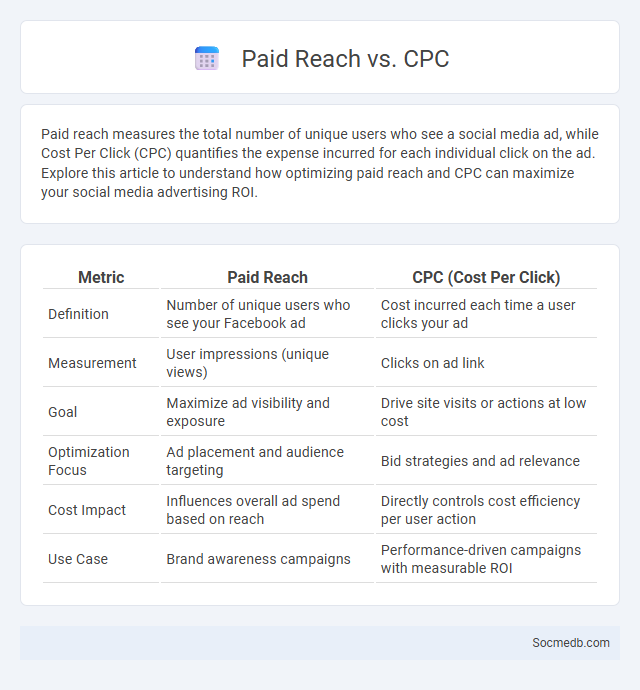
Photo illustration: Paid Reach vs CPC
Paid reach measures the total number of unique users who see a social media ad, while Cost Per Click (CPC) quantifies the expense incurred for each individual click on the ad. Explore this article to understand how optimizing paid reach and CPC can maximize your social media advertising ROI.
Table of Comparison
| Metric | Paid Reach | CPC (Cost Per Click) |
|---|---|---|
| Definition | Number of unique users who see your Facebook ad | Cost incurred each time a user clicks your ad |
| Measurement | User impressions (unique views) | Clicks on ad link |
| Goal | Maximize ad visibility and exposure | Drive site visits or actions at low cost |
| Optimization Focus | Ad placement and audience targeting | Bid strategies and ad relevance |
| Cost Impact | Influences overall ad spend based on reach | Directly controls cost efficiency per user action |
| Use Case | Brand awareness campaigns | Performance-driven campaigns with measurable ROI |
Understanding Paid Reach: Definition and Scope
Paid reach on social media refers to the number of unique users who see branded content as a result of paid promotions or advertisements. This metric captures the effectiveness of targeted ad campaigns across platforms like Facebook, Instagram, and Twitter, measuring exposure beyond organic reach. Understanding paid reach helps marketers optimize budget allocation and audience targeting to maximize visibility and engagement.
Decoding CPC: What is Cost Per Click?
Cost Per Click (CPC) is a key metric in social media advertising that determines how much you pay each time a user clicks on your ad. Understanding CPC helps you optimize your budget and improve ad performance by focusing on campaigns that generate valuable clicks. Your ability to analyze CPC data enables smarter decisions, maximizing return on investment for social media marketing efforts.
Paid Reach vs CPC: Core Differences
Paid Reach measures the total number of unique users who see your social media ad, reflecting the breadth of your campaign's exposure. CPC (Cost Per Click) indicates the amount you pay each time a user clicks on your ad, highlighting engagement efficiency and budget effectiveness. Understanding these core differences helps you optimize your social media strategy by balancing visibility with cost control to maximize your return on investment.
How Paid Reach Impacts Brand Visibility
Paid reach on social media significantly enhances your brand visibility by targeting specific demographics and expanding audience reach beyond organic followers. Investing in paid campaigns increases content exposure in users' feeds, driving higher engagement rates and potential customer conversions. Leveraging data-driven targeting ensures your brand message reaches the most relevant audience, maximizing the impact of every marketing dollar spent.
Measuring Success: Key Metrics for Paid Reach and CPC
Measuring success in social media advertising hinges on evaluating paid reach and Cost Per Click (CPC), which directly impact campaign efficiency. Paid reach quantifies the number of unique users exposed to paid content, while CPC reflects the average cost incurred for each click, enabling precise budget optimization. Tracking these key metrics facilitates outperforming industry benchmarks and refining targeting strategies for maximum return on ad spend.
Cost Implications: Budgeting for Paid Reach vs CPC
Social media advertising requires careful budgeting to balance paid reach and cost-per-click (CPC) strategies effectively. Paid reach campaigns demand upfront investment to maximize audience exposure, often resulting in higher overall costs but broader brand visibility. CPC models offer more controlled spending by charging only for actual clicks, making them cost-efficient for driving specific actions while requiring precise targeting to avoid budget wastage.
When to Use Paid Reach in Your Marketing Strategy
Paid reach should be used in a social media marketing strategy when targeting specific demographics or expanding brand visibility beyond organic followers. Leveraging paid reach allows precise audience segmentation through platforms like Facebook Ads and Instagram Sponsored Posts, maximizing engagement and conversion rates. Strategic investment in paid reach is essential during product launches, promotional campaigns, and retargeting efforts to ensure higher ROI and measurable results.
CPC Campaigns: Best Practices and Tips
Effective CPC campaigns on social media require precise audience targeting using detailed demographics and interest-based filters to maximize ad relevance and click-through rates. Crafting compelling ad copies with strong calls-to-action and visually appealing creatives significantly improves engagement and conversion metrics. Continuous performance analysis with tools like Facebook Ads Manager enables optimization of bidding strategies and budget allocation for higher return on ad spend (ROAS).
Combining Paid Reach and CPC for Maximum ROI
Combining paid reach and cost-per-click (CPC) strategies on social media maximizes your return on investment by targeting precise audience segments while controlling ad spend. Paid reach amplifies content exposure, increasing brand awareness across platforms like Facebook and Instagram, while CPC campaigns optimize budget efficiency by charging only for actual engagement. You can leverage analytics to continuously refine these tactics, boosting conversions and driving sustainable growth.
Choosing the Right Approach: Paid Reach, CPC, or Both?
Choosing the right social media strategy depends on your marketing goals and budget. Paid reach campaigns increase brand visibility by targeting specific audiences, while CPC (cost-per-click) models optimize for direct engagement and conversions. Your best approach may involve combining both to maximize reach and drive measurable actions.
 socmedb.com
socmedb.com